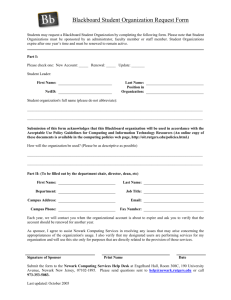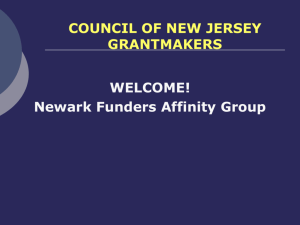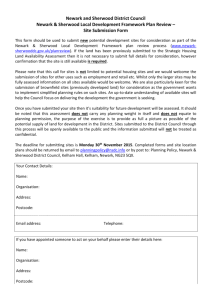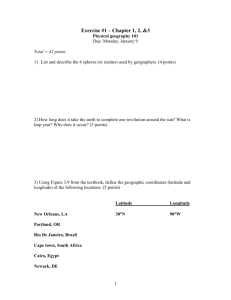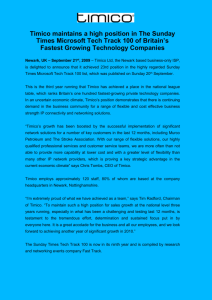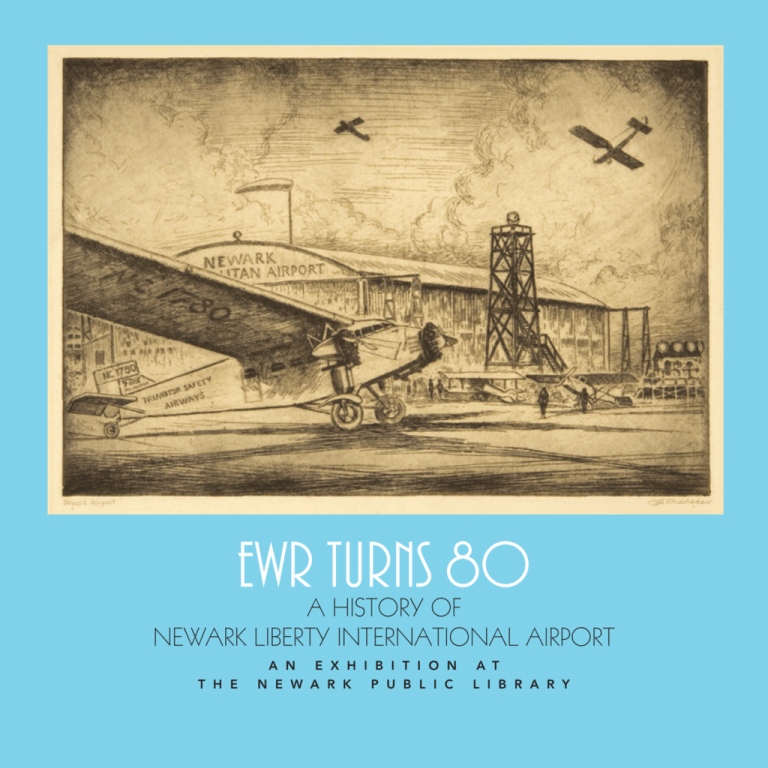
EWR TURNS 80
A HISTORY OF
NEWARK LIBERTY INTERNATIONAL AIRPORT
T H E
A N
E X H I B I T I O N
N E W A R K
P U B L I C
A T
L I B R A R Y
front cover image: Newark Airport, etching by George A. Bradshaw, done for the Journal of Finance and Industry , 1929.
From the Special Collections of The Newark Public Library.
above: The airport in the 1950s, with the Newark skyline in the background.
EWR TURNS 80
A HISTORY OF
NEWARK LIBERTY INTERNATIONAL AIRPORT
A N
T H E
E X H I B I T I O N
N E W A R K
P U B L I C
A T
L I B R A R Y
James Lewis, Curator
The Charles F. Cummings New Jersey Information Center
The Newark Public Library
Exhibition on view April 7 – June 14, 2008
Second- and Third-Floor Galleries
www.npl.org
This exhibition was made
possible by a grant from the
Port Authority of NY & NJ.
EWR TURNS 80
A HISTORY OF NEWARK LIBERTY INTERNATIONAL AIRPORT
SPECIAL ACKNOWLEDGMENTS
This exhibition was made possible by a generous grant
from the Port Authority of NY & NJ
Richard Koles, Photographer/Local Historian
Shea Oakley, Aviation Hall of Fame and Museum of New Jersey
Christine Baird, The Star-Ledger
Lisa Boley, The Star-Ledger
Diana Dade, The Ninety-Nines – Garden State Chapter
Janet DeJesus, The Star-Ledger
Jessica Dobrin, Port Authority of NY & NJ
Patti Hudziak, Continental Airlines
Gloria Melo, TAP Portugal
David Morris, Retired, Newark Liberty International Airport
Jeffrey Moy, Newark Museum
Tom Peitz, FedEx
William Peniston, Newark Museum
H.V. Reilly, Author
Pim Van Hemmen, The Star-Ledger
We wish to extend a posthumous THANK YOU to Jean-Rae Turner, Local Historian.
EWR TURNS 80: A HISTORY OF NEWARK LIBERTY INTERNATIONAL AIRPORT
THE NEWARK PUBLIC LIBRARY 2008
EWR TURNS 80
A HISTORY OF NEWARK LIBERTY INTERNATIONAL AIRPORT
HONORARY CHAIRPERSON
Susan Bass Levin, Port Authority of NY & NJ
HONORARY COMMITTEE
Geoffrey Arend, Air Cargo News
C. Louis Bassano, FedEx
Arlene Feldman, NJ Aviation Association
Al Frank, The Star-Ledger
John Jacoby, Newark Liberty International Airport
Pamela Jasper, The Organization of Black Airline Pilots
Richard Koles, Historian and Photographer
The Honorable Frank Lautenberg, United States Senate
David Morris, Retired, Newark Liberty International Airport
Shea Oakley, Aviation Hall of Fame and Museum of NJ
Marilyn Patierno, North Jersey Chapter of the Ninety-Nines
John B. Perry, Council for Airport Opportunity
Martin J. Schwartz, Essex County Building Trades Council
Monica Slater Stokes, Continental Airlines
Stephanie Vigilotti, PrimeFlight Aviation Services
EWR TURNS 80: A HISTORY OF NEWARK LIBERTY INTERNATIONAL AIRPORT
THE NEWARK PUBLIC LIBRARY 2008
April 7, 2008
Dear Friends,
This year marks the 80th anniversary of Newark Liberty International Airport.
In commemoration of this event, the Newark Public Library is pleased to
present EWR Turns 80: A History of Newark Liberty International Airport.
This landmark exhibition of photos, ephemera, and memorabilia will be on
view at the Library from April 7 through June 14, 2008.
On behalf of the Trustees and staff of the Newark Public Library, thank you
for joining us as we celebrate this special anniversary and the development
of commercial aviation in New Jersey.
We are most grateful to The Port Authority of New York & New Jersey for
their generous grant in support of this exhibition and Susan Bass Levin,
Port Authority First Deputy Executive Director, for serving as the honorary
chairperson of the exhibit committee. We also appreciate the participation
of the entire honorary exhibit committee.
Librarian and curator, James Lewis, did an outstanding job of organizing
the many facets of this exhibit. In addition, we would like to acknowledge
an extraordinary volunteer, Richard Koles, who conceived the idea for
EWR Turns 80 and lent his expertise throughout its development.
The exhibit draws heavily on collections from the Library’s local history
department, the Charles F. Cummings New Jersey Information Center.
We are grateful to the many other individuals, organizations and corporations
that contributed materials and expertise in support of this exhibit.
We hope that you enjoy this rich historical collection and that
EWR Turns 80 will evoke many fond memories for you!
Sincerely,
Wilma J. Grey
Director
EWR TURNS 80: A HISTORY OF NEWARK LIBERTY INTERNATIONAL AIRPORT
THE NEWARK PUBLIC LIBRARY 2008
April 7, 2008
Dear Friends,
The Port Authority of NY and NJ (PANYNJ) is proud to be the lead sponsor of the Newark Public Library’s
exhibit “EWR Turns 80: A History of the Newark Liberty International Airport.”
The first major airport to open in the New York-New Jersey metropolitan area, Newark Airport was built by
the City of Newark on 68 acres of marshland. It opened on October 1, 1928, and quickly became the world's
busiest commercial airport. Its rich history—with many aviation firsts—includes flights by Charles Lindbergh
and the dedication by Amelia Earhart of the Administration building in 1935, which served as the first
commercial airline terminal in the nation.
During World War II, the Army Air Corps operated the airport. In 1948, after the PANYNJ assumed
responsibility for its operation, the agency added an instrument runway, a terminal building, a control tower
and an air cargo center. Through the 70s and 80s the PANYNJ made additional investments in terminals,
which led to the eventual expansion of the facility into an international airport. Today, through its ten-year
capital program, the PANYNJ is continuing its commitment to make Newark Liberty International a premiere
facility. The capital program includes the modernization of Terminal B, runway rehabilitation work, safety and
mechanical upgrades totaling over $443 billion dollars.
Historically one of the nation’s busiest airports, in 2006 Newark Liberty International transported over 35
million passengers. The PANYNJ has worked to be a partner and good neighbor to the surrounding
communities. The agency is proud to work with Mayor Cory Booker, the City Council led by Council
President Mildred Crump, Elizabeth Mayor J. Christian Bollwage and all of the elected officials in the region
who support the facility. Through the rich collection of photographs, artifacts and memorabilia, the Newark
Public Library’s exhibit will provide to the public a view of the extraordinary history not only of the airport
itself, but also of the aviation industry, the City and the region.
On behalf of the PANYNJ, I extend my appreciation to the Library’s Board of Trustees and
Staff for their hard work and enthusiasm at producing this great exhibit of Newark Liberty
International’s 80-year lifespan.
Enjoy the exhibit.
Sincerely,
Susan Bass Levin
First Deputy Executive Director
EWR TURNS 80: A HISTORY OF NEWARK LIBERTY INTERNATIONAL AIRPORT
THE NEWARK PUBLIC LIBRARY 2008
EWR TURNS 80
A HISTORY OF NEWARK LIBERTY INTERNATIONAL AIRPORT
n the early 1920s most
Americans looked upon
aviation much as we look
upon space flight—more as a
curiosity than as a development
likely to have significant
economic impact. When aviation
enthusiasts first asked Newark
officials to consider establishing
I
an airport, the city’s leaders
showed little enthusiasm for the
idea. They were convinced that
upgrades to the shipping
facilities at Port Newark would
yield greater benefits.
only an amusing—and probably
transient—novelty. Newark
officials soon reassessed their
decision not to build a municipal
airport and proceeded to build
one with lightning speed.
Charles Lindbergh’s 1927 flight
across the Atlantic changed the
prevailing view that aviation was
On August 3, 1927, Thomas
Lynch Raymond, the mayor,
announced plans to provide
1. “Newark Airport Plans:
Mayor Announces Details of
Proposed $6,000,000
Project,” New York Times,
August 4, 1927, p. 12.
2. “Where Airways Will
Converge: Work on Big
Newark Base for Planes,
Intended To Serve the New
York District, Is Being Rushed
in Hope of Readiness for
Summer,” New York Times,
February 19, 1928, p. 124.
EWR TURNS 80: A HISTORY OF NEWARK LIBERTY INTERNATIONAL AIRPORT
Newark Liberty International
Airport had the first paved
runway in the country.
From The Port of New York
Authority.
THE NEWARK PUBLIC LIBRARY 2008
Thomas Lynch Raymond was mayor of Newark in 1928
and played a key role in the development of Newark
Airport. He died days before the grand opening.
Flood light system used in the 1930s at Newark Airport.
$6,000,000 for a commercial airport
at Port Newark.1 He stated that it
would be owned and operated by the
city and would be “the most modern
and best equipped in the nation.”
Officials touted its proximity to a
deep-sea waterway, “providing not
only landing space and anchorage for
seaplanes, but also a direct contact
with twenty-one steamship lines”2 as
well as its proximity to five railroads,
the Pennsylvania, the Baltimore &
Ohio, the Philadelphia & Reading, the
Lehigh, the Central Railroad of New
Jersey, and to the Newark Belt line,
which connected the five.
Heller Field was located in Newark’s North Ward and was in operation from December 1919 to May 1921
as a U.S. Mail airfield. Here, mail bags are dropped from wells in the forward part of the fuselage.
From the Newark Evening News , December 8, 1919.
EWR TURNS 80: A HISTORY OF NEWARK LIBERTY INTERNATIONAL AIRPORT
THE NEWARK PUBLIC LIBRARY 2008
Thomas Alva Edison talks with
Captain James Ray at Newark Airport.
Photo by Drew B. Peters for the Sunday Call .
3. Ibid.
4. “Where Airways Will
Converge,” New York Times,
February 19, 1928, p. 124.
5. “Air Mail Abandons Hadley
Field Port: Postmaster
General Thinks It Is Too Far
Away From New York City.
New Field Is Near Newark,”
New York Times, August 8,
1928, p. 15.
6. “New Airport for Newark:
Some $4,000,000 Will Be
Used to Bring Busy Field Fully
Up to Date,” New York Times,
November 24, 1935, p. XX5.
The city engaged the American
Airports Corporation to plan and
oversee the construction of the
facility. The airport was built on
swampland, raised with landfill
to eleven feet above sea level.
The plans, which required diversion of three streams, provided
for numerous innovations such
as a circular landing field (which
would facilitate optimum use of
landing space despite changes in
wind direction, and would make
it possible for several planes to
land or take off at the same
time), runway marker lights, and
radio beacons (which would
guide a plane to a safe landing
through fog),3 as well as the
nation’s first hard-surface runway.
“Newark makes little secret of
the fact,” the New York Times
reported on February 18, 1928,
“that it is rushing the development of the airport in an effort
to capture the air-mail business
of the metropolitan district.
Several contracts which the mailcarrying air transport companies
have with Hadley Field, at
New Brunswick, terminate about
Aug. 1.”4 The city’s efforts to
accelerate construction were not
in vain. The Times reported on
August 8 of the same year:
“Postmaster General Barry S.
New announced today that
Hadley Field, N.J., used as an air
mail port since Dec. 15, 1924,
will be abandoned on Oct. 1,
and a new airport located near
Newark, will be used to supply
New York City and surrounding
territory.”5
Passenger service was soon
inaugurated. Initially the city
lacked funds to build a
EWR TURNS 80: A HISTORY OF NEWARK LIBERTY INTERNATIONAL AIRPORT
passenger terminal, and each
airline built its own. “If passengers wanted to transfer from a
United Air Lines plane to an
American Airlines machine for a
trip to Boston, they had to walk
across the cinders, through mud
or dust, as the situation might
be, from United’s station to
American’s.”6 Nevertheless,
Newark soon became the world’s
busiest commercial airport.
THE NEWARK PUBLIC LIBRARY 2008
Passengers on new Newark–Washington plane line.
Left to right are J.V. MacGee, former vice president of
Transcontinental Air Transport; A.W. Gilliam, Washington
newspaper representative; Amelia Earhart, vice president of
the line; Mrs. Mabel Walker Willebrandt, former Assistant
United States Attorney General; Major General J.E. Fechet,
chief of the United States Army Air Corps; Commander
J.Q. Walton of the Coast Guard and Sydney Gross of
Washington. September 1930.
below: Entrance to Administration Building
also known as Building One.
7. Ibid.
In 1931 90,177 travelers used it.7
Increased passenger traffic led to a
demand for amenities. Consequently,
an administration building that housed
a passenger terminal, a restaurant,
and hotel rooms was soon
constructed. Even though travel from
Newark Airport to the intersection
of Broadway and Canal Street in
Manhattan took only 12 minutes,
Fiorello LaGuardia, the mayor of New
York, was intent upon establishing an
airport within the borders of the city.
A site in northeastern Queens was
chosen. The airport built there
EWR TURNS 80: A HISTORY OF NEWARK LIBERTY INTERNATIONAL AIRPORT
THE NEWARK PUBLIC LIBRARY 2008
left: Colonel Edwin E. Aldrin was commanding
Officer of Newark Airport for part of 1942. His son,
Edwin Eugene “Buzz” Aldrin Jr., a Glen Ridge native,
was the second man on the moon. Courtesy Aviation
Hall of Fame and Museum of New Jersey.
right: Gustav Heningburg.
opened in 1939. Although it was
officially named “New York Municipal Airport,” it soon came to be
called “LaGuardia Airport,” and
was officially so named in 1947.
8. “4 Airport Leases Signed
by Newark,” New York Times,
May 8, 1941, p. 19.
Four airlines established operations at LaGuardia, materially
reducing the number of flights
they made into Newark, thus
depriving Newark of revenue
needed to keep the Newark
Airport in operation. Meyer C.
Ellenstein, the mayor of Newark,
complaining that the taxpayers
of Newark were subsidizing
the airport in the amount of
$210,000 a year, demanded that
the airlines pay $135,000 a year
for use of airport facilities. They
refused to pay more than
$74,000. Therefore, on May 31,
1940, Ellenstein closed the
Newark Airport.
Newark leased the municipal
hangar to Brewster Aeronautical
Corporation for use in the
manufacture of airplanes.
The city received income from
the arrangement, which also
promised to bring 1,500 jobs
to Newark.
Negotiations involving the city,
the airlines, and the Civil Aeronautics Administration, brokered
by Colonel Edwin E. Aldrin of
Montclair, resulted in the reopening of the airport a year later.
Aldrin was chosen to manage
the facility.8
EWR TURNS 80: A HISTORY OF NEWARK LIBERTY INTERNATIONAL AIRPORT
The U.S. Army Air Corps took
over the entire airport during
World War II, and all commercial
flights were suspended.
After the War the City of Newark
entered into an agreement with
the Port of New York Authority
(later renamed the Port Authority
of New York and New Jersey),
under which the city leased the
airport to the Port Authority.
New York similarly leased its
airports to the Port Authority.
The next two decades saw
significant increases in air travel.
Scheduled jet flights out of
Newark Airport began on
September 11, 1961. Increased
traffic led the Port Authority to
THE NEWARK PUBLIC LIBRARY 2008
plan and to effect a major expansion of the Newark Airport.
Gustav Heningburg, director of
the Greater Newark Urban
Coalition, spearheaded a campaign to ensure that members
of ethnic minorities who lived in
Newark would have access to
the high-paying construction
jobs that the airport expansion
would create. Heningburg had
support not only from the community but also from the airlines
and the Port Authority. The
skilled-trades unions, however,
opposed his efforts
vehemently. The
dispute delayed completion of the work for
over a year; but
Heningburg and his
allies ultimately prevailed.9 One third of
the skilled workers who
completed the work on
all three new terminals,
and, indeed, on subsequent construction
projects in Newark,
were members of
ethnic minorities.
9. “Newark’s Black Leaders
Are Hopeful Of Achieving
Construction-Job Goals,”
New York Times, October 17,
1972, p. B6.
The first two terminals
opened in August and
September 1973. The
expansion enabled the
airport to accommodate a large number of
international flights.
Accordingly, “Newark Airport”
was renamed “Newark International Airport.” Unfortunately,
soon after the first two new
terminals opened, an economic
downturn coupled with sharp
increases in the price of fuel led
to a decrease in air travel, which
was reversed only after deregulation of the airlines in 1978.
In the early 1980s a new airline,
People Express, which offered
“no frills” flights to England at
low cost, set up its operations at
Newark, generating a marked
increase in passenger traffic.
Within a few years Newark
became the busiest of the three
major airports in the New York
Metropolitan Area. Indeed,
People Express undertook the
completion of the third new
terminal to accommodate its
customers. The fledgling airline
eventually faltered and was
bought by Continental Airlines.
Continental became the airport’s
largest carrier and bears
responsibility for much of its
subsequent development.
Allegheny Airlines hostesses: Agnes Charney, Diane Frank, Betty Gutowski. September 1968.
EWR TURNS 80: A HISTORY OF NEWARK LIBERTY INTERNATIONAL AIRPORT
THE NEWARK PUBLIC LIBRARY 2008
People Express captains Beverly Burns of Roselle, left,
and Lynn Rippelmeyer of Sparta go through pre-flight
preparations in the cockpit of a Boeing 747 at Newark
International Airport. They became the first women to
pilot Boeing 747 passenger jumbo jets on July 18, 1984.
Photo by Rick Bowmer, courtesy of The Star-Ledger .
© 2008. The Star-Ledger.
All rights reserved. Reprinted with permission.
In time passenger traffic
declined again, but increases in
freight traffic offset the decline.
Both Federal Express and United
Parcel Service opened facilities
at the airport.
station on the Northeast Corridor
rail line, adjacent to the airport,
and the monorail was extended
to transport passengers from
the rail station to the airport
terminals.
On June 1, 1996, a monorail that
links the terminals with each
other and with the parking lots
went into operation. In 2001
New Jersey Transit opened a
Today Newark Liberty
International Airport stands as
the 13th busiest in the nation
and the 22nd busiest in the
world. Its development during
EWR TURNS 80: A HISTORY OF NEWARK LIBERTY INTERNATIONAL AIRPORT
the past eighty years reveals the
wisdom and prescience of
Thomas Lynch Raymond and
other Newark leaders who in
1927 recognized its potential
value and moved quickly to
create it within a year.
—Bruce E. Ford
Assistant Director
for Access Services
The Newark Public Library
THE NEWARK PUBLIC LIBRARY 2008
above: Passengers board an Eastern Airlines plane in 1951.
back cover image: Continental Flight 99 bound for Hong Kong taxis away from Terminal C, Gate 134 at Newark Liberty International Airport
with the city of Newark shown in the background, March 3, 2005. Photo by Tony Kudzuk, courtesy of The Star-Ledger .
© 2008. The Star-Ledger. All rights reserved. Reprinted with permission.
The Newark Public Library
5 Washington Street, Newark, NJ 07102
973-733-7775
www.npl.org


